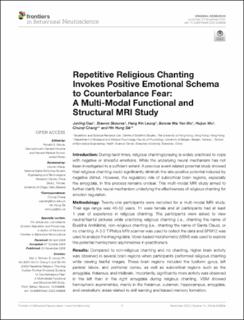| dc.contributor.author | Gao, Junling | |
| dc.contributor.author | Skouras, Stavros | |
| dc.contributor.author | Leung, Hang Kin | |
| dc.contributor.author | Wu, Bonnie Wai Yan | |
| dc.contributor.author | Wu, Huijun | |
| dc.contributor.author | Chang, Chunqi | |
| dc.contributor.author | Sik, Hin Hung | |
| dc.date.accessioned | 2021-08-09T08:21:56Z | |
| dc.date.available | 2021-08-09T08:21:56Z | |
| dc.date.created | 2021-03-17T14:44:05Z | |
| dc.date.issued | 2020 | |
| dc.identifier.issn | 1662-5153 | |
| dc.identifier.uri | https://hdl.handle.net/11250/2766893 | |
| dc.description.abstract | Introduction: During hard times, religious chanting/praying is widely practiced to cope with negative or stressful emotions. While the underlying neural mechanism has not been investigated to a sufficient extent. A previous event-related potential study showed that religious chanting could significantly diminish the late-positive potential induced by negative stimuli. However, the regulatory role of subcortical brain regions, especially the amygdala, in this process remains unclear. This multi-modal MRI study aimed to further clarify the neural mechanism underlying the effectiveness of religious chanting for emotion regulation.
Methodology: Twenty-one participants were recruited for a multi-modal MRI study. Their age range was 40–52 years, 11 were female and all participants had at least 1 year of experience in religious chanting. The participants were asked to view neutral/fearful pictures while practicing religious chanting (i.e., chanting the name of Buddha Amitābha), non-religious chanting (i.e., chanting the name of Santa Claus), or no chanting. A 3.0 T Philips MRI scanner was used to collect the data and SPM12 was used to analyze the imaging data. Voxel-based morphometry (VBM) was used to explore the potential hemispheric asymmetries in practitioners.
Results: Compared to non-religious chanting and no chanting, higher brain activity was observed in several brain regions when participants performed religious chanting while viewing fearful images. These brain regions included the fusiform gyrus, left parietal lobule, and prefrontal cortex, as well as subcortical regions such as the amygdala, thalamus, and midbrain. Importantly, significantly more activity was observed in the left than in the right amygdala during religious chanting. VBM showed hemispheric asymmetries, mainly in the thalamus, putamen, hippocampus, amygdala, and cerebellum; areas related to skill learning and biased memory formation.
Conclusion: This preliminary study showed that repetitive religious chanting may induce strong brain activity, especially in response to stimuli with negative valence. Practicing religious chanting may structurally lateralize a network of brain areas involved in biased memory formation. These functional and structural results suggest that religious chanting helps to form a positive schema to counterbalance negative emotions. Future randomized control studies are necessary to confirm the neural mechanism related to religious chanting in coping with stress and negative emotions. | en_US |
| dc.language.iso | eng | en_US |
| dc.publisher | Frontiers Media | en_US |
| dc.rights | Navngivelse 4.0 Internasjonal | * |
| dc.rights.uri | http://creativecommons.org/licenses/by/4.0/deed.no | * |
| dc.title | Repetitive Religious Chanting Invokes Positive Emotional Schema to Counterbalance Fear: A Multi-Modal Functional and Structural MRI Study | en_US |
| dc.type | Journal article | en_US |
| dc.type | Peer reviewed | en_US |
| dc.description.version | publishedVersion | en_US |
| dc.rights.holder | Copyright 2020 Gao, Skouras, Leung, Wu, Wu, Chang and Sik | en_US |
| dc.source.articlenumber | 548856 | en_US |
| cristin.ispublished | true | |
| cristin.fulltext | original | |
| cristin.qualitycode | 1 | |
| dc.identifier.doi | 10.3389/fnbeh.2020.548856 | |
| dc.identifier.cristin | 1898720 | |
| dc.source.journal | Frontiers in Behavioral Neuroscience | en_US |
| dc.identifier.citation | Frontiers in Behavioral Neuroscience. 2020, 14, 548856. | en_US |
| dc.source.volume | 14 | en_US |

